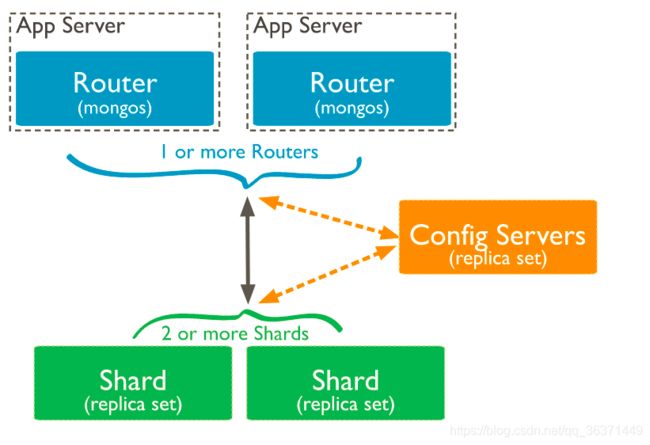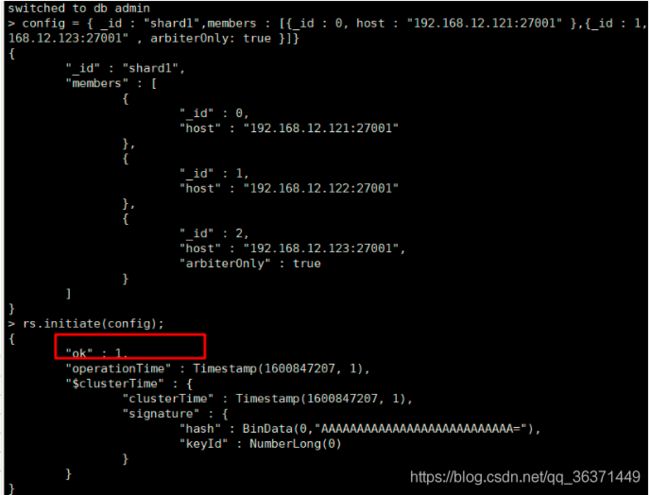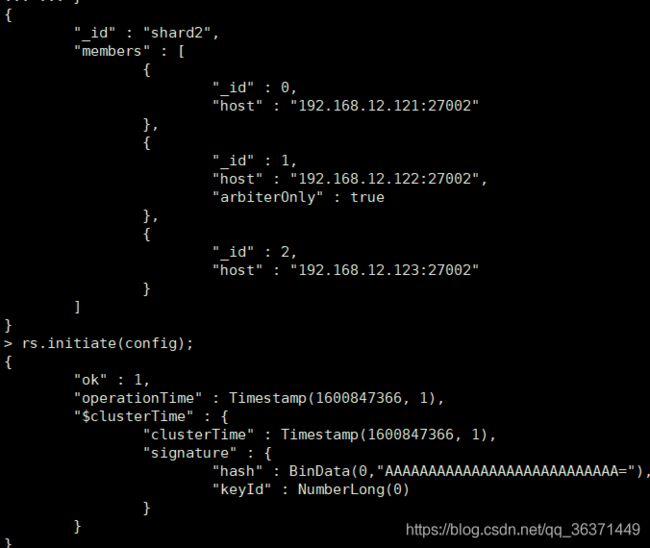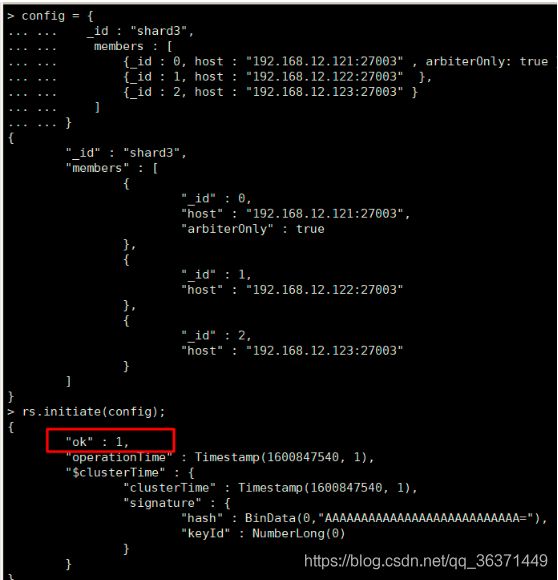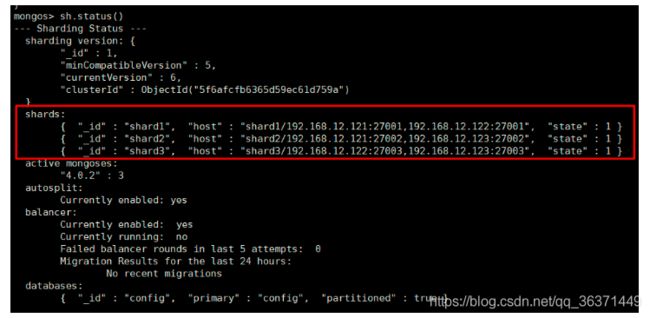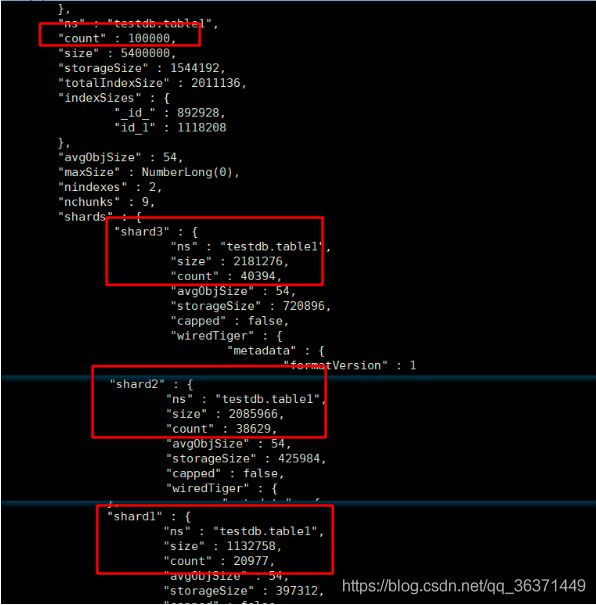mongodb集群搭建详情分片+副本集
在搭建集群之前,需要首先了解几个概念:路由,分片、副本集、配置服务器等。
从图中可以看到有四个组件:mongos、config server、shard、replica set。
-
mongos,数据库集群请求的入口,所有的请求都通过mongos进行协调,不需要在应用程序添加一个路由选择器,mongos自己就是一个请求分发中心,它负责把对应的数据请求请求转发到对应的shard服务器上。在生产环境通常有多mongos作为请求的入口,防止其中一个挂掉所有的mongodb请求都没有办法操作。
-
config server,顾名思义为配置服务器,存储所有数据库元信息(路由、分片)的配置。mongos本身没有物理存储分片服务器和数据路由信息,只是缓存在内存里,配置服务器则实际存储这些数据。mongos第一次启动或者关掉重启就会从 config server 加载配置信息,以后如果配置服务器信息变化会通知到所有的 mongos 更新自己的状态,这样 mongos 就能继续准确路由。在生产环境通常有多个 config server 配置服务器,因为它存储了分片路由的元数据,防止数据丢失!
-
shard,分片(sharding)是指将数据库拆分,将其分散在不同的机器上的过程。将数据分散到不同的机器上,不需要功能强大的服务器就可以存储更多的数据和处理更大的负载。基本思想就是将集合切成小块,这些块分散到若干片里,每个片只负责总数据的一部分,最后通过一个均衡器来对各个分片进行均衡(数据迁移)。
-
replica set,中文翻译副本集,其实就是shard的备份,防止shard挂掉之后数据丢失。复制提供了数据的冗余备份,并在多个服务器上存储数据副本,提高了数据的可用性, 并可以保证数据的安全性。
-
仲裁者(Arbiter),是复制集中的一个MongoDB实例,它并不保存数据。仲裁节点使用最小的资源并且不要求硬件设备,不能将Arbiter部署在同一个数据集节点中,可以部署在其他应用服务器或者监视服务器中,也可部署在单独的虚拟机中。为了确保复制集中有奇数的投票成员(包括primary),需要添加仲裁节点做为投票,否则primary不能运行时不会自动切换primary。
简单了解之后,我们可以这样总结一下,应用请求mongos来操作mongodb的增删改查,配置服务器存储数据库元信息,并且和mongos做同步,数据最终存入在shard(分片)上,为了防止数据丢失同步在副本集中存储了一份,仲裁在数据存储到分片的时候决定存储到哪个节点。
环境准备
系统系统 centos 7.0
- 三台服务器:node_1(192.168.12.121)、node_2(192.168.12.121)、node_3(192.168.12.121)
| 服务器node1(192.168.12.121) | 服务器node2(192.168.12.122) | 服务器node3(192.168.12.123 |
|---|---|---|
| mongos | mongos | mongos |
| config server | config server | config server |
| shard server1 主节点 | shard server1 副节点 | shard server1 仲裁 |
| shard server2 仲裁 | shard server2 主节点 | shard server1 副节点 |
| shard server3 副节点 | shard server3 仲裁 | shard server3 主节点 |
端口分配:
mongos:20000 config:21000 shard1:27001 shard2:27002 shard3:27003
分别在每台机器建立conf、mongos、config、shard1、shard2、shard3六个目录,因为mongos不存储数据,只需要建立日志文件目录即可。
mkdir -p /export/mongodb/conf
mkdir -p /export/mongodb/server
mkdir -p /export/mongodb/mongos/log
mkdir -p /export/mongodb/config/data
mkdir -p /export/mongodb/config/log
mkdir -p /export/mongodb/shard1/data
mkdir -p /export/mongodb/shard1/log
mkdir -p /export/mongodb/shard2/data
mkdir -p /export/mongodb/shard2/log
mkdir -p /export/mongodb/shard3/data
mkdir -p /export/mongodb/shard3/log
#上传安装包到服务器
tar -zxvf mongodb-linux-x86_64-rhel62-4.0.2.tgz
#复制到另外两台机
scp mongodb-linux-x86_64-rhel62-4.0.2.tgz [email protected]:/export/mongodb/server/
环境变量
为了后续方便操作,配置mongodb的环境变量,需要切到root用户下面
vim /etc/profile
# 内容
export MONGODB_HOME=/export/mongodb/server/mongodb
export PATH=$MONGODB_HOME/bin:$PATH
# 使立即生效,在安装用户下(youknow)执行
source /etc/profile
config server配置服务器
mongodb 以后要求配置服务器也创建副本集,不然集群搭建不成功。
添加配置文件
vim /export/mongodb/conf/config.conf
## content
systemLog:
destination: file
logAppend: true
path: /export/mongodb/config/log/config.log
# Where and how to store data.
storage:
dbPath: /export/mongodb/config/data
journal:
enabled: true
# how the process runs
processManagement:
fork: true
pidFilePath: /export/mongodb/config/log/configsrv.pid
# network interfaces
net:
port: 21000
bindIp: 0.0.0.0
#operationProfiling:
replication:
replSetName: config
sharding:
clusterRole: configsvr
启动三台服务器的config server
mongod -f /export/mongodb/conf/config.conf
登录任意一台配置服务器,初始化配置副本集
连接
mongo 192.168.12.121:21000
#config变量
config = {_id : "config",members : [{_id : 0, host : "192.168.12.121:21000" },{_id : 1, host : "192.168.12.122:21000" },{_id : 2, host : "192.168.12.123:21000" }]}
#初始化副本集
rs.initiate(config)
其中,”_id” : “configs”应与配置文件中配置的 replicaction.replSetName 一致,”members” 中的 “host” 为三个节点的ip和port
这样配置服务器就配置好了
配置分片副本集(三台机器)
- 设置第一个分片副本集
配置文件
vim /export/mongodb/conf/shard1.conf
#配置文件内容
# where to write logging data.
systemLog:
destination: file
logAppend: true
path: /export/mongodb/shard1/log/shard1.log
# Where and how to store data.
storage:
dbPath: /export/mongodb/shard1/data
journal:
enabled: true
wiredTiger:
engineConfig:
cacheSizeGB: 20
# how the process runs
processManagement:
fork: true
pidFilePath: /export/mongodb/shard1/log/shard1.pid
# network interfaces
net:
port: 27001
bindIp: 0.0.0.0
#operationProfiling:
replication:
replSetName: shard1
sharding:
clusterRole: shardsvr
复制到另外两台机
修改对应IP
scp shard1.conf [email protected]:/export/mongodb/conf
启动三台服务器的shard1 server
mongod -f /export/mongodb/conf/shard1.conf
登陆任意一台服务器,初始化副本集
mongo 192.168.12.121:27001
#使用admin数据库
use admin
#定义副本集配置,第三个节点的 "arbiterOnly":true 代表其为仲裁节点。
config = { _id : "shard1",members : [{_id : 0, host : "192.168.12.121:27001" },{_id : 1, host : "192.168.12.122:27001" },{_id : 2, host : "192.168.12.123:27001" , arbiterOnly: true }]}
#初始化副本集配置
rs.initiate(config);
- 设置第二个分片副本集
配置文件
vim /export/mongodb/conf/shard2.conf
#配置文件内容
# where to write logging data.
systemLog:
destination: file
logAppend: true
path: /export/mongodb/shard2/log/shard2.log
# Where and how to store data.
storage:
dbPath: /export/mongodb/shard2/data
journal:
enabled: true
wiredTiger:
engineConfig:
cacheSizeGB: 20
# how the process runs
processManagement:
fork: true
pidFilePath: /export/mongodb/shard2/log/shard2.pid
# network interfaces
net:
port: 27002
bindIp: 0.0.0.0
#operationProfiling:
replication:
replSetName: shard2
sharding:
clusterRole: shardsvr
复制到另外两台机
修改对应IP
scp shard2.conf [email protected]:/export/mongodb/conf
启动三台服务器的shard1 server
mongod -f /export/mongodb/conf/shard2.conf
登陆任意一台服务器,初始化副本集
mongo 192.168.12.121:27002
#使用admin数据库
use admin
#定义副本集配置,第三个节点的 "arbiterOnly":true 代表其为仲裁节点。
config = {
... _id : "shard2",
... members : [
... {_id : 0, host : "192.168.12.121:27002" },
... {_id : 1, host : "192.168.12.122:27002", arbiterOnly: true },
... {_id : 2, host : "192.168.12.123:27002" }
... ]
... }
#初始化副本集配置
rs.initiate(config);
- 设置第三个分片副本集
配置文件
vim /export/mongodb/conf/shard3.conf
#配置文件内容
# where to write logging data.
systemLog:
destination: file
logAppend: true
path: /export/mongodb/shard3/log/shard3.log
# Where and how to store data.
storage:
dbPath: /export/mongodb/shard3/data
journal:
enabled: true
wiredTiger:
engineConfig:
cacheSizeGB: 20
# how the process runs
processManagement:
fork: true
pidFilePath: /export/mongodb/shard3/log/shard3.pid
# network interfaces
net:
port: 27003
bindIp: 0.0.0.0
#operationProfiling:
replication:
replSetName: shard3
sharding:
clusterRole: shardsvr
复制到另外两台机
修改对应IP
scp shard3.conf [email protected]:/export/mongodb/conf
启动三台服务器的shard1 server
mongod -f /export/mongodb/conf/shard3.conf
登陆任意一台服务器,初始化副本集
mongo 192.168.12.122:27003
#使用admin数据库
use admin
#定义副本集配置,第三个节点的 "arbiterOnly":true 代表其为仲裁节点。
config = {
... _id : "shard3",
... members : [
... {_id : 0, host : "192.168.12.121:27003" , arbiterOnly: true },
... {_id : 1, host : "192.168.12.122:27003" },
... {_id : 2, host : "192.168.12.123:27003" }
... ]
... }
#初始化副本集配置
rs.initiate(config);
配置路由服务器 mongos
先启动配置服务器和分片服务器,后启动路由实例:(三台机器)
vim /export/mongodb/conf/mongos.conf
#内容
systemLog:
destination: file
logAppend: true
path: /export/mongodb/mongos/log/mongos.log
processManagement:
fork: true
# pidFilePath: /export/mongodb/mongos/log/mongos.pid
# network interfaces
net:
port: 20000
bindIp: 0.0.0.0
#监听的配置服务器,只能有1个或者3个 configs为配置服务器的副本集名字
sharding:
configDB: config/192.168.12.121:21000,192.168.12.122:21000,192.168.12.123:21000
复制到另外两台机
修改对应IP
scp /export/mongodb/conf/mongos.conf [email protected]:/export/mongodb/conf
启动三台服务器的mongos server
mongos -f /export/mongodb/conf/mongos.conf
启用分片
目前搭建了mongodb配置服务器、路由服务器,各个分片服务器,不过应用程序连接到mongos路由服务器并不能使用分片机制,还需要在程序里设置分片配置,让分片生效。
登陆任意一台mongos
mongo 192.168.12.121:20000
#使用admin数据库
use admin
#串联路由服务器与分配副本集
sh.addShard("shard1/192.168.12.121:27001,192.168.12.122:27001,192.168.12.123:27001")
sh.addShard("shard2/192.168.12.121:27002,192.168.12.122:27002,192.168.12.123:27002")
sh.addShard("shard3/192.168.12.121:27003,192.168.12.122:27003,192.168.12.123:27003")
#查看集群状态
sh.status()
测试
目前配置服务、路由服务、分片服务、副本集服务都已经串联起来了,但我们的目的是希望插入数据,数据能够自动分片。连接在mongos上,准备让指定的数据库、指定的集合分片生效。
# 指定testdb分片生效
db.runCommand( { enablesharding :"testdb"});
#指定数据库里需要分片的集合和片键
db.runCommand( { shardcollection : "testdb.table1",key : {id: 1} } )
mongos> use config
switched to db config
mongos> db.settings.save({"_id":"chunksize","value":1}) //设置块大小为1M是方便实验,不然就需要插入海量数据
WriteResult({ "nMatched" : 0, "nUpserted" : 1, "nModified" : 0, "_id" : "chunksize" })
#使用testdb
use testdb;
#插入测试数据
for (var i = 1; i <= 100000; i++)
db.table1.save({id:i,"test1":"testval1"});
#查看分片情况如下,部分无关信息省掉了
db.table1.stats();
后期运维
启动关闭
mongodb的启动顺序是,先启动配置服务器,在启动分片,最后启动mongos.
mongod -f /export/mongodb/conf/config.conf
mongod -f /export/mongodb/conf/shard1.conf
mongod -f /export/mongodb/conf/shard2.conf
mongod -f /export/mongodb/conf/shard3.conf
mongod -f /export/mongodb/conf/mongos.conf
ps -aux | grep mongodb;
tail -n2200 shard2.log |sed -n ‘/2020-11-30 15:20:00/,/2020-11-30 16:20:00/p’
